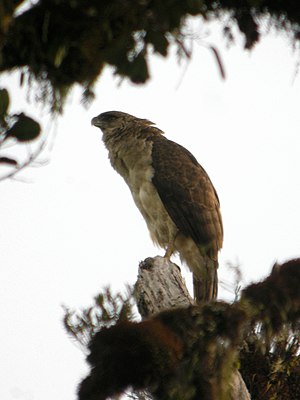Papuan eagle
| Papuan eagle | ||||||||||||
|---|---|---|---|---|---|---|---|---|---|---|---|---|

Papua eagle ( Harpyopsis novaeguineae ) |
||||||||||||
| Systematics | ||||||||||||
|
||||||||||||
| Scientific name | ||||||||||||
| Harpyopsis novaeguineae | ||||||||||||
| Salvadori , 1875 |
The Papua eagle ( Harpyopsis novaeguineae ) is a bird of prey endemic to New Guinea . It is also called the New Guinea strangler eagle , Kapul eagle or harpy eagle and, in the latter case, should not be confused with the relatively closely related harpy eagle ( Harpia harpyja ) that lives in Latin America . It is a large bird that occurs all over the island with the exception of the highest regions of the high mountains. The species is monotypical .
Appearance
The eagle is colored brown to gray-brown in all plumage, the head is somewhat lighter. Striking is an erectable, brown and white speckled feather bonnet. The mighty beak is black. The neck and chest are striped gray-brown on a light background, the belly and the underside of the tail are very light, almost white. The iris color probably changes with age from brown to yellow to red. The relatively long yellow legs with strong black claws are also striking. In flight the eagle looks very light, the outer coverts of the arm and hand wings and the tips of the arm and hand wings are dark gray to black. The relatively short but broad wings and the long tail enable the Papuan eagle to maneuver nimbly in its habitat.
The reverse sex dimorphism is very clear in terms of size and mass (males only reach about 64% of the mass of a female), the sexes hardly differ in color.
In its area of distribution, the species is not to be confused with any other bird of prey.
The body length (from the tip of the beak to the tip of the tail) is between 72 centimeters and 90 centimeters, the wingspan of very large females can reach 160 centimeters.
voice
The far-reaching calls of this eagle are as impressive as they are unusual. They form a series of deeper uumph , occasionally also ookh - sounds. Couples use these calls to communicate over great distances.
Habitat and Distribution
The habitat of the Papu eagle is inaccessible original forest areas in New Guinea. It occurs from the mangrove and gallery forests near the coast to mountain regions at 2000 meters above sea level. Occasionally it is also found at altitudes above 3500 meters.
Food and subsistence
It feeds primarily on mammals such as small marsupials and rodents . In addition, snakes and reptiles as well as domestic animals such as pigs and dogs belong to its prey.
The prey animals are cut both in the branches of the trees and on the ground. Tree-dwelling mammals, such as climbing bags, are often swept from the branches and only killed on the ground. The spring hood may have a function in acoustic location of the prey.
Breeding biology
Very little is known about the breeding biology of the species. The type of pair bond is also unknown. The species breeds between late April to November, but probably not every year. Only one young is raised in a nest that has been used for several years.
Duration
Due to the threats posed by hunting (its feathers are used as jewelry) and habitat loss, the IUCN lists the species as endangered ( vulnerable ). However, no precise information can be given about the size of the population; there may be more animals than assumed in the inaccessible forests of his home country.
literature
- James Ferguson-Lees , David A. Christie: Raptors of the World. Houghton Mifflin Company Boston, New York 2001, pp. 226 & 720-721.
Web links
- Harpyopsis novaeguineae inthe IUCN Red List of Threatened Species 2013.1. Listed by: BirdLife International, 2012. Retrieved November 18, 2013.